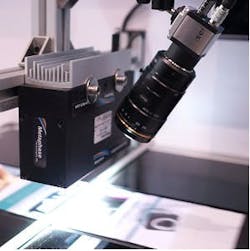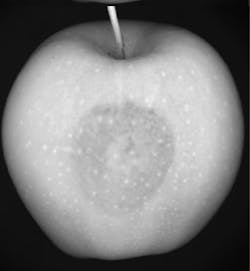How Advanced LED Control Techniques Are Solving Machine Vision’s Toughest Challenges
What You’ll Learn
- How pulse control improves image clarity and reduces heat in high-speed inspections
- Why overdrive lighting boosts brightness for capturing fast-moving products
- Ways adaptive lighting enables quick changeovers and multi-product inspection
- How spectral tuning enhances defect detection by adjusting light wavelengths
- What smarter lighting systems mean for the future of machine vision flexibility
Over the past decade, machine vision technology has had to evolve constantly to keep pace with new and fast-emerging manufacturing applications. Accelerating line speeds in manufacturing and logistics have constantly demanded faster image capture with no loss of quality. Increasingly stringent inspection tolerances have pushed industrial cameras to capture more or finer details for defect detection. And production lines geared for fast, frequent changeovers have driven vision system designs that can adapt more quickly to new tasks.
Despite these trends—and often because of them—LED lighting for machine vision remains as critical as ever to enhance system performance, reliability and value. As a result, illumination engineers have innovated quickly to address these new challenges in manufacturing and vision technology.
This is evident in three key trends that continue to reshape machine vision lighting today:
- Pulse control and timing solutions that synchronize lighting with vision systems or each other to manage heat and power consumption
- Overdrive techniques that produce dramatically higher light output for brief periods to enhance contrast in the image and lower the signal-to-noise ratio during high-speed inspections
- Adaptive lighting technology that significantly enhances operational flexibility by allowing single lighting fixtures to adapt illumination characteristics to different inspection tasks
As each of these lighting technologies continues to advance, new solutions, such as spectral tuning capabilities, continue to emerge, promising even greater optimization potential in the future.
Pulse Control for Precision Synchronization
Pulse control represents a fundamentally different approach to LED illumination than conventional “always-on” lighting. By synchronizing light delivery with a camera’s shutter, pulse control offers both operational and performance advantages to machine vision systems, particularly those involving faster line speeds or variations in ambient lighting.
Vision system design generally aims for each pixel of a camera sensor to resolve one corresponding detail of an object being imaged. Objects in motion can complicate this aim. If an object is moving too quickly in relation to the camera’s exposure time, a single point on its surface might be captured across multiple pixels, which causes pixel blur in the image.
The solution generally involves shortening the camera’s exposure time to effectively freeze objects in motion. Cameras have accelerated shutter speeds accordingly to accommodate inspection of high-speed processes, and high-intensity LED lighting ensures enough photons still reach the camera sensor to support high-speed image capture. By synchronizing LED output with shutter speeds, pulse control allows lighting to manage power consumption and heat more efficiently while delivering maximum image contrast. This can also improve the overall lifetime of LED devices.
More sophisticated LED drivers and controllers can trigger precise, nearly square-shaped pulses optimized to deliver peak intensity only when the camera’s shutter is open. For most applications, however, it is enough for controllers to ensure pulses share a consistent width and amplitude to minimize noise resulting from variations in intensity.
READ MORE: Picking Precision: Advantages of Robotics in Agriculture
LED pulse control relies on two common trigger interfaces. Transistor-transistor logic (TTL) triggers provide simple digital on/off control, making them suitable for basic synchronization applications. Positive-negative-positive (PNP) transistor-based triggers—and corresponding NPN triggers—offer more robust signal handling and can drive higher current loads. These capabilities make them preferable for applications that require more precise timing control or when interfacing with industrial control systems that operate at different voltage levels.
In practice, the output intensity of an LED lighting fixture is capped not by its maximum allowable current, but by its thermal limit. This particularly applies to large fixtures that are densely populated with LEDs. Driving currents higher in an LED elevates its operating temperature, which results in a diminishing rate of return for output intensities. That is, at higher temperatures an LED’s efficiency drops, and overheating can eventually lead to failure.
Active cooling—either via fans, liquid chillers or compressed air—counters these effects in always-on LED lighting, though it adds to a system’s complexity, footprint and power consumption. All cooling methods also introduce another potential point of failure that might contribute to system downtime.
Pulsing LEDs offer a simpler method to keep temperatures under control and can further drive them to deliver two to three times higher brightness than when in their always-on state. Brighter output, in turn, helps reduce the impact of ambient light on image acquisition or allows machine vision cameras to operate with a reduced aperture to increase depth of field.
Overdrive Delivers Maximum Intensity
Overdrive techniques expressly aim to strobe LEDs beyond their continuous rating for brief periods to drive significantly higher intensities. The principle behind overdrive operation involves briefly pulsing LEDs at currents that would quickly damage them under continuous operation and then switching them off for a specific rest time. In machine vision applications, LEDs are typically overdriven at four to 10 times their rated current to provide four to eight times their rated output. To achieve this, they typically maintain duty cycles below 10%, and pulse widths less than 2 ms.
Such currents would be unsustainable in constant operation and require longer rest times, which means more limited LED duty cycles than pulse control. However, like pulse control techniques, overdriving LEDs reduces average operating temperatures and power consumption while delivering far brighter pulses. This capability has proved particularly valuable for high-speed imaging operations where camera exposure times drop below 100 ms in order to capture clear images of bar codes or defects on a fast-moving production line.
The technique relies either on built-in drivers or external pulse-follow approaches to maintain precise control over light pulses. Built-in overdrive systems integrate control electronics directly into the lighting fixture, which offers simpler, more compact installations but less flexibility on pulse timing. Pulse-follow systems based on external controllers allow more control to shape overdrive parameters and can coordinate multiple lighting zones, but they typically require additional hardware and more complex integration.
Adaptive Lighting for Flexible Manufacturing
The term “adaptive lighting” can encompass a wide range of techniques and lighting architectures. The basic aim is to allow lighting fixtures to adapt their illumination profiles on the fly to address different machine vision tasks.
Replacing a machine vision lighting system requires far more attention to engineering, integration and alignment than replacing conventional illumination. And, once installed, it typically offers very limited changes to lighting geometry, focus or intensity distribution. Such static lighting features are fine for most vision applications because they are typically dedicated to performing similar inspections over long periods. But some manufacturing operations are geared to produce a variety of products on the same equipment or production lines, which requires vision systems able to quickly adapt their parameters to accommodate new tasks and product features.
Within this context, “adaptable” lighting solutions can range from simple solutions that allow lenses to be manually switched for different working distances to cutting-edge programmable LED arrays with software-controlled intensity distribution. Programmable arrays allow individual LED segments to be controlled independently, enabling different intensity patterns across the illuminated area. These systems can highlight specific features, create uniform illumination across varying product sizes or optimize contrast for different surface materials within the same inspection setup.
READ MORE: How to Upgrade Quality Control for Better Performance
Tunable field-of-view systems fall somewhere in between these two options in terms of complexity. More sophisticated than manually adjustable systems and more commercially mature than programmable LED arrays, tunable field-of-view fixtures incorporate multiple LED channels with different beam angles that can be mixed and controlled remotely. This approach allows a single fixture to adapt from inspecting small components requiring concentrated illumination to larger products needing broader coverage, without mechanical adjustments or overly complicated control schemes.
Adaptive lighting can significantly accelerate changeover time and improve inspection consistency across product variations. Production lines handling multiple package sizes, for example, can optimize illumination height and beam characteristics as different products move through inspection stations. This eliminates time-consuming installation and alignment of new lighting installations and reduces the potential for human error in system reconfiguration.
However, adaptive lighting systems can also introduce complexity and costs that must be weighed against these benefits. Software-controlled systems require more numerous and sophisticated electronics as well as integration with production management systems to coordinate lighting changes with product changeovers. With the increased electronic complexity comes additional potential failure points.
Integration challenges often prove more significant than anticipated. Adaptive lighting systems must interface with production line controls, vision processing software, and quality management systems to function effectively. This often requires programming expertise and systematic testing to ensure reliable operation across all product configurations. The coordination between multiple system components can also complicate troubleshooting complexity when issues arise.
Cost considerations extend beyond the initial hardware investment. Adaptive lighting systems can also require more extensive commissioning time, ongoing software maintenance, and specialized technical support compared to fixed installations. The return on investment depends heavily on changeover frequency and the cost of alternative approaches, such as dedicated lighting for each product type.
Emerging Trends and Future Technologies
Adaptive illumination systems represent the cutting-edge of machine vision lighting and could potentially deliver even more sophisticated capabilities such as real-time dynamic optimization of lighting parameters based on inspection feedback and environmental conditions.
Yet, new illumination techniques and capabilities continue to emerge. For example, lighting engineers are exploring spectral tuning systems that offer dynamic wavelength selection to enhance image contrast and feature detection. Such systems would incorporate different LEDs to allow adjustments to a light’s spectral output profile.
READ MORE: The Vision of Sustainable Agriculture: Laser-Focused on a Weed-Free Farm
Changing the wavelength of light can heighten contrast in images of different materials and defects, and spectral tuning systems can automatically select the most effective illumination wavelength for each inspection task.
Consider a pharmaceutical packaging application, such as inspecting clear glass vials for contamination. Illuminating the vials under various wavelengths could detect different contaminant types or even defects in the glass. A spectral tuning system can automatically cycle through optimal wavelengths for each defect type during inspection, improving detection reliability while maintaining high throughput.
As with any lighting solution, greater sophistication comes with increased system complexity and higher costs compared to conventional illumination. Spectral tuning requires sophisticated control systems to manage its multiple LED arrays, and combining multiple arrays increases overall cost. In some applications, however, the ability to dynamically optimize inspection for multiple defect types could justify the additional investment, particularly in applications where detection reliability is critical.
The Future of Illumination
Trends in current and emerging machine vision illumination suggest the technology’s evolution has lost no momentum. Advancements in pulse control, overdrive capabilities and adaptive lighting reflect the broader evolution of manufacturing toward more flexible, efficient and intelligent systems. These lighting advances enable machine vision applications that once seemed impractical or impossible while improving the performance and economics of existing inspection tasks.
Engineers evaluating these technologies should consider their specific application requirements, integration complexity and long-term potential. Pulse control enhances LED efficiency, thermal management and versatility, while overdrive technology excels at maximizing illumination intensity in high-speed imaging applications. Adaptive lighting facilitates frequent changeovers and inspection of variable products but remains too specialized for manufacturing operations dedicated to single tasks.
Advances in both adaptive illumination and spectral tuning, however, suggest that the future of machine vision illumination is oriented toward more intelligent and dynamic capabilities. As these technologies mature and costs decrease, they will likely become standard features rather than specialized options, fundamentally changing how engineers approach machine vision system design. Future lighting systems could transform from a supporting element to an active contributor to more intelligent vision systems, capable of adapting and optimizing performance in real-time to meet changing requirements.
About the Author

Lukasz Maksymiuk
Director of Engineering, Metaphase Technologies
Lukasz Maksymiuk is currently director of engineering at Metaphase Technologies Inc., where he leads the development of new products—from concept through design and production. He received a Ph.D. in Photonics from Warsaw University of Technology in 2009, and his expertise spans laser and LED systems, optical packaging, optoelectronics and product development.




